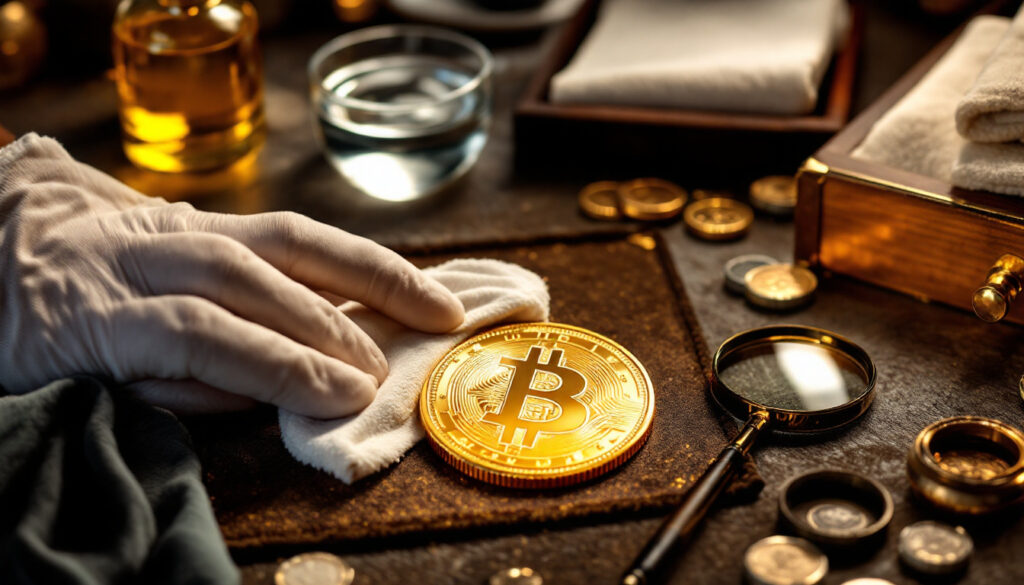How to Clean Gold Coins: A Comprehensive Guide
Gold coins are more than just currency or investments—they're pieces of history with both financial and aesthetic value. While it might seem logical to clean your gold coins to make them shine, improper cleaning methods can significantly damage their worth. This guide will walk you through how to safely clean gold coins while preserving their numismatic value.
Understanding the Value of Gold Coins
Gold coins hold dual value: their gold content (intrinsic value) and their collector's value (numismatic premium). Many collectors are surprised to learn that a coin's condition doesn't always equate to cleanliness—in fact, artificial cleaning often removes the natural patina that collectors prize.
The Importance of Proper Coin Maintenance
Expert numismatists estimate that improper cleaning can reduce a coin's market value by 50-80% in seconds. Gold coins, despite being one of the most durable precious metals, still require careful handling. The American Numismatic Association notes that even fingerprints contain oils and acids that can etch into a coin's surface over time.
"The most expensive mistake new collectors make is improperly cleaning valuable coins," says James Bucki, a professional numismatist with over 25 years of experience. "Once you've stripped a coin's original surface, that damage is permanent and irreversible."
When to Clean vs. When to Leave Alone
As a general rule, uncirculated and rare coins should never be cleaned without professional consultation. For common, circulated gold coins showing dirt accumulation, gentle cleaning may be appropriate. Professional conservationists recommend cleaning only when:
- The coin contains harmful contaminants that could cause long-term damage
- The coin's details are obscured by removable foreign matter
- The coin is common with minimal numismatic premium above gold value
A 2018 study by Heritage Auctions found that professionally cleaned rare gold coins sold for an average of 30% less than their uncleaned counterparts in similar condition. Additionally, historical trends in gold demonstrate that well-preserved coins often appreciate faster than those that have been improperly maintained.
Why Are Safe Cleaning Methods Essential?
Preserving Numismatic Value
Gold coins develop a natural patina over time that collectors and auction houses consider desirable. This subtle coloration tells the coin's age and history, providing authentication factors that experts look for when valuing coins.
"Natural toning on gold coins can actually increase their value by 15-20% among serious collectors," notes Scott Travers, author of "The Coin Collector's Survival Manual." "Once you clean that away, it can never be authentically restored."
Common Damage from Improper Cleaning
Improper cleaning methods can cause:
- Microscopic scratches that appear as hairlines under magnification
- Chemical etching from acidic solutions
- Loss of original mint luster and color
- Removal of protective patina that prevents further oxidation
The Professional Coin Grading Service (PCGS) reports that approximately 60% of submitted coins show evidence of improper cleaning, significantly reducing their grade and value. Understanding these risks is crucial for collectors who also track the broader gold market analysis to maximize their investment returns.
What Supplies Do You Need for Safe Cleaning?
Essential Cleaning Tools
- Soft microfiber cloths (never paper towels or tissues)
- Distilled water (tap water contains minerals that can leave residue)
- Mild, non-detergent soap (like Ivory)
- Soft cotton gloves for handling
- Plastic containers (never metal)
- Soft-bristled brush (optional, for crevices)
Optional Specialized Equipment
- Jeweler's loupe or magnifying glass (10x magnification recommended)
- Acid-free coin holders for drying and storage
- Professional conservation solutions (MS70 or similar)
- Photography equipment to document coin condition before cleaning
Specialized supply kits from reputable numismatic suppliers typically range from $30-$100, a small investment compared to potential value preservation. For those also investing in gold ETFs 2024, proper cleaning tools represent a tiny fraction of a diversified gold investment strategy.
How to Clean Gold Coins Safely: Step-by-Step Methods
The Soap and Water Method
This method is appropriate for moderately soiled circulated gold coins:
- Line a small plastic bowl with a soft cloth
- Fill with distilled water and add a single drop of mild soap
- Place the coin in the solution for 1-2 minutes (never soak gold coins)
- Using gloved hands, gently roll the coin between your fingertips
- Rinse thoroughly with distilled water
- Air dry on a soft cloth, never rub or pat dry
- Once completely dry, transfer to proper storage
The Olive Oil Method
For coins with stubborn organic deposits:
- Place the coin in a plastic container
- Cover with pure, extra virgin olive oil
- Let sit for 24-48 hours (check periodically)
- Remove and gently rinse with distilled water
- If necessary, use a soft brush to gently remove loosened debris
- Rinse again and air dry completely
"The olive oil method dissolves organic compounds without damaging the metal," explains David Bowers, numismatic author and researcher. "It's been used by museum conservators for centuries."
The Jewelry Cleaner Method
For common gold bullion coins with minimal numismatic premium:
- Select a cleaner specifically formulated for gold (never silver cleaners)
- Test on an inconspicuous area first
- Follow manufacturer's instructions precisely
- Rinse thoroughly with distilled water
- Air dry completely
Professional numismatists caution that this method should only be used on modern bullion coins intended primarily for their gold content. For more specialized advice on gold coin care, the Royal Mint offers comprehensive guidance on maintaining both coins and bullion bars.
How to Clean Ancient or Rare Gold Coins
Special Considerations for Valuable Coins
Coins valued at over $100 deserve special consideration. The American Numismatic Society recommends:
- Photographing the coin from multiple angles before attempting any cleaning
- Consulting with a professional numismatist or conservator
- Obtaining a professional appraisal to understand potential value impact
- Considering professional conservation services for coins minted before 1933
Gentle Techniques for Historical Pieces
If professional services aren't immediately available:
- Use only the "dust removal" technique: gently brush with a soft camel hair brush
- Avoid all liquids, including water
- Use compressed air (at low pressure) to remove loose particles
- Store in acid-free holders immediately after inspection
Current gold stocks performance shows that physical gold coins often outperform mining equities, making proper care of these tangible assets even more important for serious investors.
What Methods Should You Avoid?
Damaging Cleaning Techniques
Never use these damaging methods:
- Abrasive cleaners (including baking soda, toothpaste, or commercial metal polishes)
- Scrubbing motions or pressure cleaning
- Tape or adhesives for removing particles
- Bleach, ammonia, or any chemical solutions
- Ultrasonic cleaners (they can damage surfaces and loosen design elements)
Common Household Products to Avoid
Many seemingly innocent household products can permanently damage gold coins:
- Lemon juice/vinegar (acids etch gold alloys)
- Alcohol (removes protective coatings)
- Ketchup (contains acids and abrasives)
- Commercial silver dips (extremely harmful to gold)
- Salt solutions (promote corrosion in alloyed coins)
The Melbourne Mint provides excellent resources on specific products to avoid when maintaining gold coins of Australian origin.
Professional Cleaning Services: When to Use Them
Finding Reputable Coin Cleaning Specialists
For valuable coins, professional conservation is worth the investment:
- Seek services from established firms connected to major grading services
- Check for membership in professional organizations like ANA
- Request references and examples of previously conserved coins
- Expect to pay $30-$150 per coin depending on value and condition
What Professional Services Offer
Professional conservation services provide:
- Proper documentation and before/after photography
- Specialized techniques not available to collectors
- Appropriate conservation methods based on metallic composition
- Stabilization treatments to prevent future deterioration
- Authentication and potential grading upon completion
The Numismatic Conservation Service (NCS) reports that properly conserved rare gold coins typically retain 85-95% of their potential market value, compared to just 40-60% for improperly self-cleaned examples. This value preservation becomes increasingly important as experts analyze the gold market outlook 2025 for potential price increases.
How to Store Gold Coins After Cleaning
Optimal Storage Conditions
Proper storage is essential for maintaining cleanliness:
- Maintain 30-55% relative humidity
- Keep temperature stable between 65-72°F (18-22°C)
- Avoid direct sunlight and fluorescent lighting
- Store away from wooden furniture (which can emit harmful gases)
- Prevent exposure to air pollutants and household chemicals
Storage Products and Solutions
Invest in quality storage systems:
- Non-PVC, inert plastic holders (Mylar or polyethylene)
- Air-tight capsules for individual coins
- Albums with sulfur-free pages
- Safe deposit boxes for valuable collections
- Silica gel packets to control humidity in home storage
FAQ About Cleaning Gold Coins
Can cleaning gold coins decrease their value?
Yes, improper cleaning almost always decreases value. Professional grading services like PCGS and NGC can detect even minor cleaning, resulting in lower grades and "cleaned" notations that significantly impact resale value. Studies show that improperly cleaned rare gold coins typically sell for 30-60% less than those with original surfaces.
How often should gold coins be cleaned?
Ideally, gold coins should rarely—if ever—need cleaning if properly stored. The American Numismatic Association recommends periodic visual inspection rather than routine cleaning. If you notice new contamination, first improve storage conditions and consider cleaning only if absolutely necessary.
What's the difference between cleaning and conservation?
Cleaning focuses on improving appearance by removing surface material, often damaging the coin. Conservation, by contrast, stabilizes the coin's condition, removes harmful contaminants, and preserves original surfaces without altering the natural patina or evidence of age.
Long-Term Protection for Your Gold Coin Investment
Preventative Maintenance Strategies
Prevention is far superior to cleaning:
- Handle coins only by edges, preferably with cotton gloves
- Store in temperature and humidity-controlled environments
- Conduct quarterly visual inspections
- Keep coins away from paper, cardboard, and wooden containers
- Avoid exposure to household chemicals and cleaners
Documentation and Insurance
Protect your investment with proper records:
- Create a detailed inventory with photographs and descriptions
- Update valuations annually for insurance purposes
- Consider specialized collectibles insurance (homeowner's policies often limit coverage)
- Store documentation separately from your collection
- Keep purchase receipts and certificates of authenticity
By following these guidelines, you'll preserve both the beauty and value of your gold coins for generations to come. Remember that patience and restraint are often the best cleaning tools—when in doubt, consult a professional rather than risk permanent damage to your numismatic treasures.
Ready to Spot the Next Major Gold Discovery?
Stay ahead of the market with Discovery Alert's proprietary Discovery IQ model that instantly identifies significant ASX mineral discoveries, including potential gold opportunities. Visit the Discovery Alert discoveries page to understand how major mineral discoveries can lead to substantial returns and begin your 30-day free trial today.




